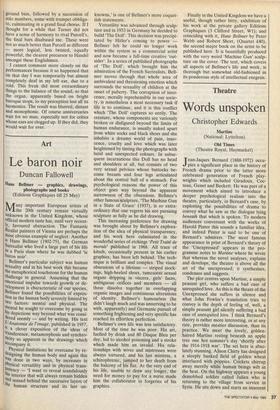Art
Le baron noir
Duncan Fallowell
Hans Beilmer — graphics, drawings, photographs and books (Editions Graphiques till 25 May) Many .important European artists of the 20th century remain virtually unknown in the United Kingdom, whose Official modern taste has, until very recent- ly, favoured abstraction. The Fantastic Realist painters of Vienna are perhaps the Most obvious example of neglect. Another Is Hans Bellmer (1902-75), the German Surrealist who lived a large part of his life In a Paris slum where he was dubbed 'le baron noir'.
Bellmer's particular subject was human sexuality and in his best work this became the metaphorical touchstone for the human Challenge in general. Assuming that the emotional impulse towards growth or de- velopment is characteristic of our species, B.ellmer found the possibilities of expres- alon in the human body severely limited by two factors: mental and physical. The Mental he sought to overcome by going in his depictions way beyond what was consi- dered seemly — and by writing. His text !-'Anatomie de l'image, published in 1957, Is a clever exposition of the ideas of transference, metamorphosis and synchro- alcity so apparent in the drawings which accompany it. Physical limitations he overcame by re- designing the human body and again this Was done in two ways, by increases in Physical versatility and in physical trans- Parency 'I want to reveal scandalously the interior that will always remain hidden and sensed behind the successive layers of the human structure and its last un-
knowns,' is one of Bellmer's more coquet- tish statements.
Versatility was advanced through sculp- ture and in 1933 in Germany he decided to build 'The Doll'. This decision was precipi- tated by Hitler's coming to power — Bellmer felt he could no longer work within the system as a commercial artist and now became a full-time creative 'out- sider'. In a series of published photographs of 'The Doll', which brought him the admiration of the French Surrealists, Bell- mer moves through that whole area of ambivalent and threatening emotion which surrounds the sexuality of children at the onset of puberty. The corruption of inno- cence, morally reprehensible in our socie- ty, is nonetheless a most necessary task if life is to continue, and it is this conflict which 'The Doll' captures so eerily. The creature, whose components are variously broken or disfigured beyond the limits of human endurance, is usually naked apart from white socks and black shoes and she inhabits a dreamy world of pain, inno- cence, cruelty and love which was later heightened by tinting the photographs with lurid and unexpected colours. In subse- quent incarnations this Doll has no head and shoulders at all, but consists of two very sexual pelvises whose buttocks be- come breasts and four legs articulated about the central ball of a stomach. For psychological reasons the power of this object goes way beyond the apparent narrowness of the obsessions. Bellmer's other famous sculpture, 'The Machine Gun in a State of Grace' (1937), is so extra- ordinary that one regrets his not pursuing sculpture as fully as he did drawing.
This increasing preference for drawing was brought about by Bellmer's explora- tion of the idea of physical transparency, and his work here culminated in the wonderful series of etchings 'Petit Traite de morale' published in 1968. All trace of kitsch, occasionally present in his earlier graphics, has been left behind. The tech- nique is brilliant and complex. The visual obsessions of a lifetime — striped stock- ings, high-heeled shoes, tumescent sexual organs dripping in viscera, girls' faces, ambiguous orifices and members — all these dissolve together in overlapping organic images and continuous alterations of identity. Bellmer's humourless (he didn't laugh much and was unnerving to be with, apparently) and Germanic pursuit of something frightening and very specific has reached its effortless perfection.
Bellmer's own life was less satisfactory. Most of the time he was poor. His art, fuelled by drink and 80 Disque Bleu per day, led to alcohol poisoning and a stroke which made him an invalid. His rela- tionships with wives and mistresses were always tortured, and his last mistress, a schizophrenic, jumped to her death from the balcony of his flat. At the very end of his life, unable to draw any longer, the need for money to pay for a nurse made him the collaborator in forgeries of his graphics.
Finally in the United Kingdom we have a useful, though rather bitty, exhibition of his work at the private gallery Editions Graphiques (3 Clifford Street, W1); and coinciding with it, Hans Bellmer by Peter Webb and Robert Short, (Quartet £40), the second major book on the artist to be published here. It is beautifully produced with the very weird 'Machine Gun' sculp- ture on the cover. The text, which covers all aspects of Bellmer's life and work, is thorough but somewhat old-fashioned in its ponderous style of intellectual exegesis.


















































 Previous page
Previous page